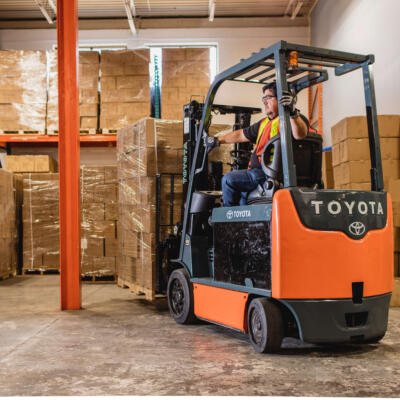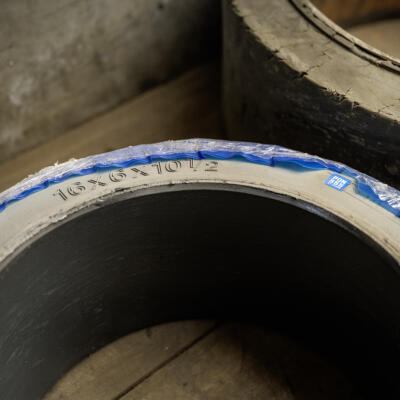Complete guide to non-marking forklift tires for industrial applications
*This article is based on our former articles: "Busting the myths with non-marking tires" and "8 factors when choosing non-marking tires". An update was made in October 2024.
Grey non-marking tires: a performance choice
Non-marking means the tires leave no marks on the floor, not that they have to be white or grey. These tires are crucial in environments where cleanliness and hygiene are top priorities: airports, hospitals, warehouses, grocery stores, and trade show floors.
At Camso, we initially produced white non-marking tires. By 2006, performance limitations led us to innovate: grey tires made from 100% natural rubber, providing longer lifespan, enhanced thermal resistance, and lower operating costs without compromising performance.
The grey color comes from adding 0.1% carbon black to stabilize the rubber, ensuring durability and optimal performance. This small adjustment is what makes Camso non marking forklift tires stand out.
Key factors when choosing non-marking forklift tires
#1 Leaving no marks on the floor
The most obvious requirement: non marking tires should leave no tire marks or black dust behind. Otherwise, they are just regular tires. Camso non-marking tires ensure clean operation and are less sensitive to stains. Grey is a forgiving color as it blends with dust.
#2 Tire lifespan and overall performance
Non-marking solutions should not compromise tire performance. Natural rubber in Solideal non-marking tires enhances technical performance, reduces chunking and cutting, and provides extra age resistance due to natural antioxidants. Always ask about compounds, technical features, and performance when choosing tires. Performance depends on usage intensity; you can use our Usage Intensity Calculator to assess your forklift’s needs.
#3 Lower rolling resistance, energy consumption, and cost
Lower rolling resistance improves energy efficiency, reducing operational costs. This leads to lower fuel consumption for gas-powered forklifts and extends battery life for electric forklifts, ensuring more economical and sustainable operations.
#4 Thermal capabilities to reduce heat build-up
Medium and high-intensity applications often mean forklifts cover more distance with multiple duty cycles, increasing tire demand and reducing cooldown periods. Tires with enhanced thermal capabilities are better suited for these applications. Overlooking this factor could lead to thermal failure of non marking forklift tires.
#5 Longevity and resistance due to rubber’s natural antioxidants
There are different processes manufacturers use to produce non-marking tires. Some compounds require harsh chemicals to achieve lighter shades, while others use dyes (red or green) or minimal manipulation. The less the rubber’s natural antioxidants are altered, the better the age resistance of the final product, ensuring longer-lasting and reliable tires.
#6 Maintaining color stability
Rubber naturally darkens when exposed to heat (“cooking”). While this is not noticeable in black tires, non-marking tires use lighter silica as a reinforcement. White tires can be produced by adding bleach and chemicals, but often fail to maintain their color due to dust, particles, or heat build-up. Grey non-marking tires are less sensitive to contamination, offer better UV resistance, and reduce the “yellowing” effect common in lighter tires.
#7 Anti-shock solutions for very high-intensity operations
Because silica is used as a filler, non-marking tires are insulating rather than conductive like black tires. Static build-up in non-marking tires can reach up to 50,000 volts, causing shocks, fires, or facility damage. Anti-shock non-marking tires, such as our PON 775 NMAS, provide a safe solution for high-intensity forklift operations.
Video: understanding the benefits of non-marking tires
To better understand non marking forklift tires and make informed choices, watch these video resources:
Video 1: Non-Marking tires overview – We explain why color isn’t as important as you might think when it comes to non-marking forklift tires. Tune in to discover how our grey tires keep your floors clean while delivering top performance!
Video 2: Choosing the right non-marking forklift tires – Solideal's grey tires may appear straightforward, but it's what's beneath the surface that truly matters: performance! Discover how our non-marking tires are engineered to meet the demanding needs of various industries.

No matter your industry, from food and beverage to pulp and paper or pharmaceuticals, always consult your dealer about these factors when selecting non-marking forklift tires. Camso grey non-marking tires provide a clean working environment without compromising performance.
Discover our complete range of non-marking tires here.






























